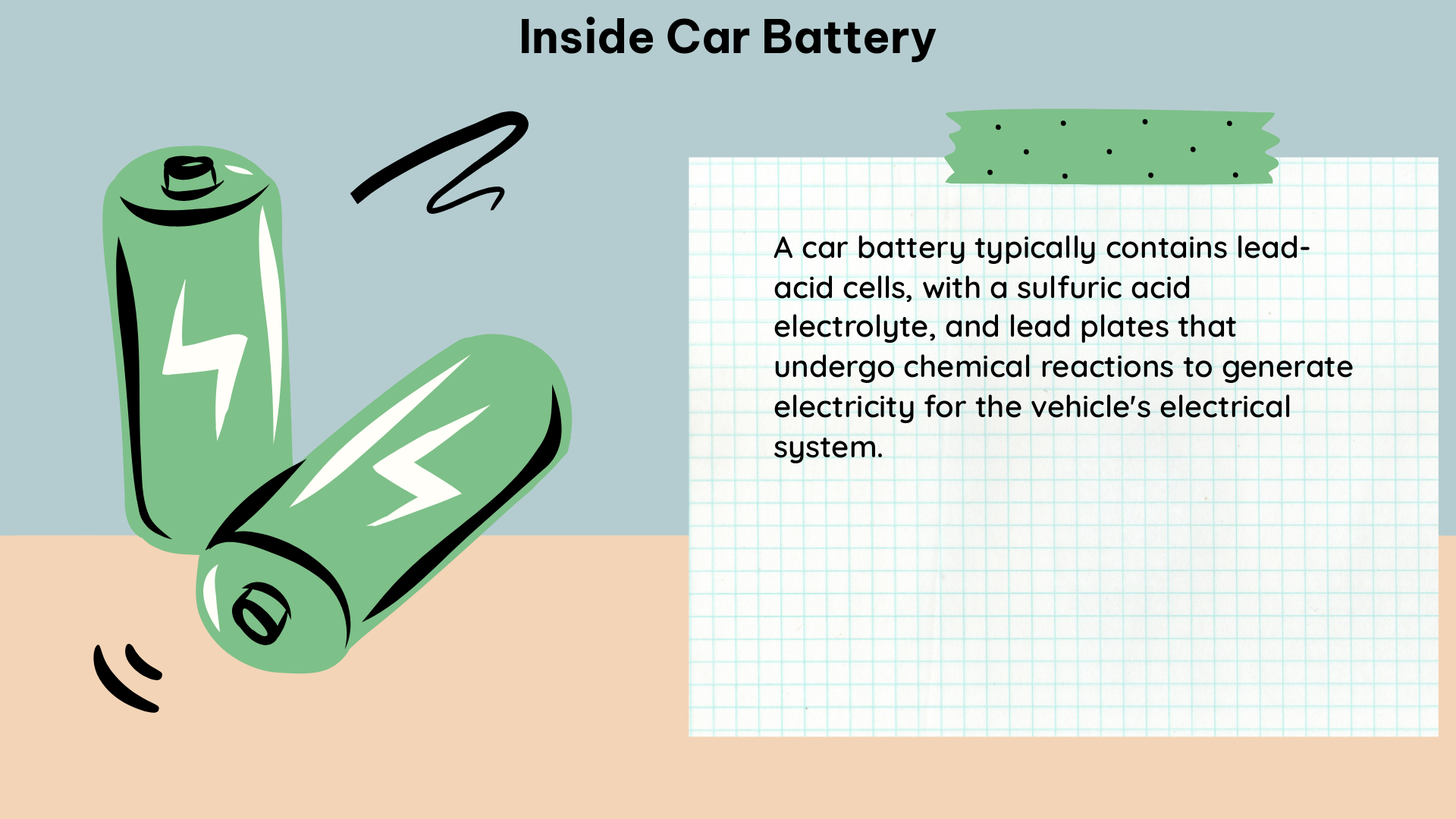The inside car battery, also known as the vehicle’s lead-acid battery, is a crucial component of any vehicle’s electrical system. It provides the necessary power to start the engine and runs various electrical systems when the engine is off. The battery’s capacity is typically measured in ampere-hours (Ah), indicating the amount of electrical charge it can deliver over time. For instance, a 50Ah battery can supply 50 amperes for one hour or 1 ampere for 50 hours.
Understanding the Anatomy of a Car Battery
A typical car battery consists of the following key components:
- Lead Plates: The positive and negative plates are made of lead and lead oxide, which are the active materials that store and release electrical energy.
- Electrolyte: The electrolyte is a sulfuric acid solution that allows the chemical reactions to take place within the battery.
- Separator: The separator is a porous material that keeps the positive and negative plates from touching, preventing short circuits.
- Container: The container is the outer casing that houses all the internal components and protects the battery.
- Terminals: The terminals, usually made of lead or copper, are the points where the electrical connections are made to the vehicle’s electrical system.
Measuring Battery Performance and Potential Issues

Parasitic Drain Measurement
Parasitic drains refer to the continuous draw of power from the battery, even when the vehicle is turned off. This can be caused by various factors, including aftermarket accessories, faulty wiring, or electronic devices that are not properly shut off. To measure parasitic drains, a digital multimeter capable of measuring tiny voltages and currents is required.
Here’s a step-by-step guide to measuring parasitic drain:
- Disconnect the negative (-) battery terminal.
- Connect the multimeter in series with the negative battery terminal and the disconnected cable.
- Set the multimeter to measure current in the appropriate range (e.g., 10A or 20A).
- Note the current reading displayed on the multimeter, which represents the parasitic drain.
Ideally, the parasitic drain should be less than 50 milliamps (0.05 amps) for a properly functioning vehicle. If the parasitic drain is higher, it’s essential to investigate and identify the source of the excessive power consumption.
Battery Capacity and Voltage Measurement
In addition to measuring parasitic drains, it’s crucial to regularly check the battery’s capacity and voltage to ensure its health and performance. Here’s how you can do it:
- Battery Capacity Measurement: The battery’s capacity can be measured using a battery load tester or a battery analyzer. These devices apply a controlled load to the battery and measure the voltage drop, which can be used to calculate the battery’s capacity in ampere-hours (Ah).
- Battery Voltage Measurement: The battery’s voltage can be measured using a digital multimeter. With the engine running, the voltage should be between 13.5V and 14.5V, indicating a properly functioning charging system. With the engine off, the voltage should be between 12.4V and 12.8V, indicating a healthy battery.
Maintaining Car Battery Health
To ensure the longevity and optimal performance of your car battery, it’s essential to follow these maintenance tips:
- Regular Cleaning: Keep the battery terminals and connections clean by removing any corrosion or buildup with a wire brush or baking soda and water solution.
- Proper Charging: Ensure that the vehicle’s charging system is functioning correctly by having it checked periodically. Overcharging or undercharging can both be detrimental to the battery’s health.
- Avoiding Extreme Temperatures: Extreme temperatures, both hot and cold, can accelerate the battery’s degradation. Park your vehicle in a shaded area or a garage whenever possible to protect the battery.
- Timely Replacement: Car batteries typically have a lifespan of 3 to 5 years, depending on usage and environmental factors. Replace the battery when it starts to show signs of wear, such as reduced cranking power or increased charging time.
Conclusion
The inside car battery is a vital component of any vehicle’s electrical system, and understanding its technical specifications and maintenance requirements can help ensure its optimal performance and longevity. By regularly measuring the battery’s performance, identifying and addressing any parasitic drains, and following proper maintenance practices, you can prolong the life of your car battery and avoid unexpected breakdowns.
References:
– Eng-Tips Forum: Measuring Parasitic Battery Drain
– Reddit Discussion: Left My Interior Lights On Overnight
– HubPages: Does It Really Kill Your Car Battery to Jump Someone Else’s Car?
– Team-BHP: Idiots Guide to Tracing Parasitic Battery Drain in Modern Cars
– YouTube Video: How to Measure Parasitic Battery Drain

The lambdageeks.com Core SME Team is a group of experienced subject matter experts from diverse scientific and technical fields including Physics, Chemistry, Technology,Electronics & Electrical Engineering, Automotive, Mechanical Engineering. Our team collaborates to create high-quality, well-researched articles on a wide range of science and technology topics for the lambdageeks.com website.
All Our Senior SME are having more than 7 Years of experience in the respective fields . They are either Working Industry Professionals or assocaited With different Universities. Refer Our Authors Page to get to know About our Core SMEs.